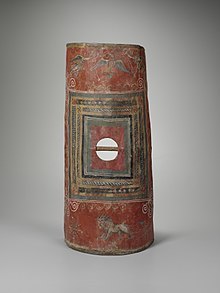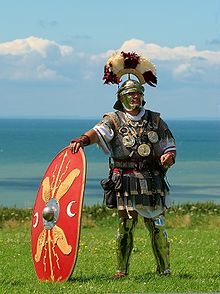Roman Weapons and Armor
The Romans were a very econoically practical civilization. The armor Roman soldiers wore changed very much throughout the centuries the Romans were around. Even though the armor they wore changed, one big aspect did not. The armor Roman soldiers typically wore did not cover the arms or legs. The Romans could have produced armor which did so but they chose not to since it would be too expensive. In addition, each soldier caried a scutum, a tall shield, to protect them. The shield would be tall enough to protect most of the body, including the arms and legs, which were not protected by armor. This shield was the primary defense and the armor was secondary.
This is an example of Roman equipment. The gladius was a shortsword used by the Roman soldiers. Gladius actually just means "sword" in Latin. Just like the gladius, the scutum was the shield the Roman soldiers used. Scutum also means "shield" in Latin.
The armor Roman soldiers are typically depicted as wearing, at least during Imperial Rome, was known as lorica segmentata, or segmented armor. This armor was crafted from various iron strips or bands and held together with strips of leather. This armor did not have and covering for the arms and legs.
The sandals which were worn by Roman soldiers were known as caligae. These were heavy sandals which were more like open-toed boots. They had flattened nails on the bottom of the soles, acting like modern cleats. In Jerusalem there actually existed a law where the native Jewish population could not wear nails on the soles of their shoes, so they would know when the Roman soldiers were coming. These nails made it much easier to walk on unevn terrain in the wilderness, but were very slippery on stone. There is actually a case where a centurion was running on stone and slipped, hit his head, and instantly died.
When a Roman soldier signed up for the military they signed up for twenty five years. Centurions were high ranking commanders which controlled a century. Centurions were almost always veterans, having already completed their twenty five years of service and wanting more action, signed up again. Centurions had armor which distinguished them from the rank-and-file soldiers they commanded. With normal soldiers the crest went from front to back and was only worn during ceremonies. With centurions the helmet crest was always worn and it went from side to side. In addition, the armor itself was not the lorica segmentata, the segmented armor, the other soldiers would wear. Centurions would wear lorica hamata, which is chainmail.

